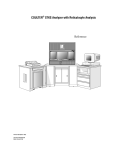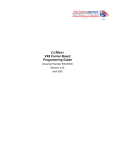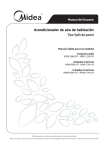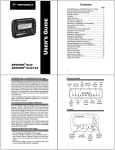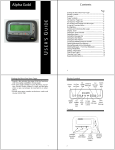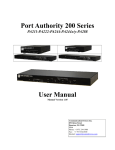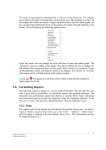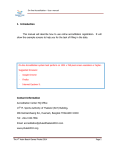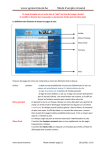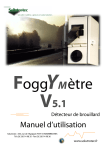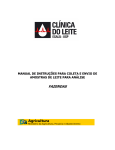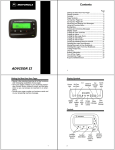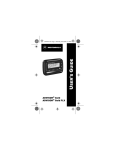Download - Frank`s Hospital Workshop
Transcript
COULTER® MicroDiff Field Service Technical Manual ® CC PN 4237161B (April 1993) TM Coulter Corporation Miami, FL 33196-2500 Coulter Corporation makes no representation that, upon furnishing this service manual, the holder of the manual will have the necessary technical capabilities and know-how to properly troubleshoot and repair any of the equipment specified in the manual. Coulter Corporation assumes no liability whatsoever, including consequential and incidental damages, resulting from improper operation of Coulter instruments after maintenance of Coulter instruments has been performed by persons not employed by Coulter Corporation. Furthermore, Coulter Corporation assumes no liability whatsovever for any personal injury or property damage resulting from maintenance and/or repair of Coulter instruments performed by persons not employed by Coulter Corporation. TRADEMARKS AccuComp, ACCUVETTE, ACCU-ZYME, AQUA-AD, AUTO-CAL, AUTO-CLONE, "CC" logo, CARDS, CASH, CHANNELYZER, CHEMOTERGE, COMPLETE CELL ANALYSIS, COULTER, COULTER CHEMISTRY, COULTER CLENZ, COULTER CLONE, THE COULTER COUNTDOWN, COULTER COUNTER, COULTER CURRENTS, COULTERAMA, CYTO-STAT, CYTO-TROL, C-ZYME, DACAL, DACOS, "DACOS" logo, DART, DIFF3, DIFF3 50, DIFF4, DILU-PACK, E.A.SY. 1, EASY 88, EASY 2, EPICS, FASTECS, 5C, 4C, HEMO-CAL, HEMOTERGE, HEMO-W, IsoFlow, ISOLYSE, ISOPET, ISOTERGE, ISOTON, KEM-O-MAT, "LFI" logo, LANGLEY FORD, LANGLEY FORD INSTRUMENTS, LEASE-PAK, LYSE S, MDADS, MINI-KEM, NANO-SIZER, OMNISORP, OptiChem, S-CAL, SOMACOUNT, SOMAFIX, SOMATON, STAIN RIGHT, STILL COUNTING, THROMBOCOUNTER, THROMBO-FUGE, U.V.-ZYME, ZAP-OGLOBIN, ZAPONIN and ZETAFUGE are trademarks of Coulter Corporation. HAZARDS AND OPERATIONAL PRECAUTIONS AND LIMITATIONS WARNINGS, CAUTIONS, and IMPORTANTS alert you as follows: WARNING: Might cause injury. CAUTION: Might cause damage to the instrument. IMPORTANT: Might cause misleading results. "This Service Manual contains confidential information of Coulter Corporation and its receipt or possession does not convey any rights to reproduce, disclose its contents, or to manufacture, use, or sell anything it may describe. Reproduction, disclosure, or use without specific written authorization of Coulter Corporation is strictly forbidden." REVISION STATUS Issue Date Draft 5/92 Initial 5/92 A 7/92 B 4/93 PN 4237161B (April 1993) Amended Pages 2-3, 2-4, 2-9, 2-10, 2-12, 2-15, 3-5, 3-6, Chapter 8 Software Level 1D i REVISION STATUS ii PN 4237161A (July 1992) TABLE OF CONTENTS 1 2 PN 4237161B (April 1993) WARNINGS AND CAUTIONS, 1-1 1.1 GENERAL SAFETY, 1-1 WARNING, 1-1 CAUTION, 1-1 IMPORTANT, 1-1 Note, 1-1 1.2 ELECTRONIC SAFETY PRECAUTIONS, 1-1 1.3 BIOLOGICAL SAFETY, 1-2 INSTRUMENT DESCRIPTION, 2-1 2.1 SPECIFICATIONS, 2-1 Dimensions/Weight, 2-1 Power, 2-1 Input, 2-1 Consumption, 2-1 Ambient Operating Temperature, 2-1 Humidity, 2-1 Recommended Reagents, 2-1 Controls and Calibrators, 2-1 Fluid Volumes, 2-2 Interfering Substances, 2-2 2.2 INTRODUCTION TO THE COULTER MicroDiff, 2-2 Function, 2-2 Mode of Operation, 2-2 2.3 DIFFERENTIAL MEASUREMENT, 2-2 2.4 OPERATIONAL OVERVIEW, 2-2 2.5 DILUTER, 2-3 General, 2-3 Count Valve 1 (VL1), 2-5 Dilution Valve 2 (VL2), 2-5 Stepper Motor Driver Card, 2-5 2.6 VENT VALVE VACUUM SENSE CARD, 2-8 2.7 ELECTRONICS ASSEMBLY, 2-8 General, 2-8 Motherboard, 2-9 Linear Power Supply, 2-10 iii TABLE OF CONTENTS Power Supply Components, 2-10 Switching Power Supply, 2-13 Data Acquisition Card, 2-14 Multi Stepper Motor Control Card (MSMC), 2-15 Input Output Resource Adapter Card (IORA), 2-17 Keyboard, 2-18 Display, 2-19 3 4 iv MICRODIFF INSTALLATION PROCEDURE, 3-1 3.1 PREINSTALLATION CHECKS, 3-1 Space and accessibility, 3-1 Power Requirements, 3-1 Ambient Temperature and Humidity, 3-1 3.2 INITIAL SETUP, 3-2 Uncrating Instrument, Accessories and Supplies, 3-2 Reagent Connections, 3-2 Printer Connection, 3-3 Power ON, 3-3 3.3 INSTRUMENT CONFIGURATION, 3-3 3.4 PRELIMINARY OPERATION CHECKS, 3-4 3.5 SETTING AIM FACTORS, 3-5 3.6 CALIBRATION, 3-5 3.7 RUNNING CONTROLS, 3-6 SERVICE/REPAIR PROCEDURES, 4-1 4.1 TOOLS AND EQUIPMENT REQUIRED, 4-1 4.2 DRIVER CARD REPLACEMENT, 4-1 Removal, 4-1 Installation, 4-1 4.3 PVAC CARD REPLACEMENT, 4-1 Installation, 4-2 4.4 MOTHERBOARD REPLACEMENT, 4-2 Removal, 4-2 Installation, 4-3 4.5 SYRINGE REPLACEMENT, 4-3 Removal, 4-3 Installation, 4-4 PN 4237161A (July 1992) TABLE OF CONTENTS PN 4237161B (April 1993) 4.6 VACUUM PUMP REPLACEMENT, 4-4 Removal, 4-4 Installation, 4-4 4.7 LYSE PUMP REPLACEMENT, 4-5 Removal, 4-5 Installation, 4-5 4.8 LYSE PUMP VERIFICATION/ADJUSTMENT, 4-5 4.9 SWITCHING POWER SUPPLY REPLACEMENT, 4-6 Removal, 4-6 Installation, 4-6 4.10 DISKETTE DRIVE REPLACEMENT, 4-7 Removal, 4-7 Installation, 4-7 4.11 DAC CARD REPLACEMENT, 4-7 Removal, 4-7 Installation, 4-8 4.12 MSMC CARD REPLACEMENT, 4-8 Removal, 4-8 Installation, 4-8 4.13 IORA CARD REPLACEMENT, 4-8 Removal, 4-8 Installation, 4-9 4.14 DISPLAY REPLACEMENT, 4-9 Removal, 4-9 Installation, 4-9 4.15 KEYPAD REPLACEMENT, 4-10 Removal, 4-10 Installation, 4-10 4.16 RED/WHITE BATH/APERTURE COMPONENT REPLACEMENT, 4-11 Hgb Detector/LED, 4-11 Removal, 4-11 Installation, 4-12 Aperture Electrode Housing Replacement, 4-12 Removal, 4-12 Installation, 4-13 Bath, 4-13 Removal, 4-13 Installation, 4-14 v TABLE OF CONTENTS CHAPTER 5 INTENTIONALLY OMITTED 6 SCHEMATIC DIAGRAMS, 6-1 CHAPTER 7 INTENTIONALLY OMITTED 8 ILLUSTRATED PARTS LIST, 8-1 8.1 PARTS LIST IN PART NUMBER ORDER, 8-1 8.2 ILLUSTRATED PARTS LISTS, 8-6 APPENDIX A ERROR CODES, A-1 A.1 MicroDiff ERROR CODES, A-1 ILLUSTRATIONS 2.1 2.2 2.3 2.4 2.5 2.6 2.7 2.8 Diluter Components, 2-4 Stepper Motor Driver Card, 2-6 Motherboard, 2-9 Linear Power Supply, 2-11 Regulator Card, 2-12 Data Acquisition Card, 2-14 Multi Stepper Motor Control Card, 2-16 Input/Output Resource Adapter Card, 2-18 8.1 8.2 8.3 8.4 8.5 8.6 8.7 8.8 Diluter, 8-6 Syringe Drive, 8-8 Linear Power Supply, 8-10 Bath, Rear View, 8-11 Bath, Front View, 8-12 Keypad and Display, 8-13 Diluent and Count Valve Display, 8-14 Carriage Assembly, 8-16 TABLES 2.1 2.2 2.3 2.4 2.5 vi Stepper Motor Driver Card Connections, 2-7 Stepper Motor Driver Card Test Points, 2-8 Terminal Block Connections, 2-12 MSMC Jumpers, 2-17 IORA Jumpers, 2-7 PN 4237161A (July 1992) WARNINGS AND CAUTIONS 1 1.1 GENERAL SAFETY Throughout this manual you will encounter the headings WARNING, CAUTION, IMPORTANT, and Note. These are provided to inform you of potentially hazardous situations and important or helpful information. WARNING A WARNING indicates a situation or procedure that, if ignored, can cause serious personal injury. A WARNING will appear in bolded text for easy identification. CAUTION A CAUTION indicates a situation or procedure that, if ignored, can cause damage to equipment. A CAUTION also appears in bolded text. IMPORTANT An IMPORTANT indicates a situation or procedure that, if ignored can result in erroneous test results. An IMPORTANT also appears in bolded text. Note A Note contains information that is important to remember or helpful in performing a procedure. 1.2 ELECTRONIC SAFETY PRECAUTIONS WARNING Remove rings and other metal jewelry before performing maintenance or service on the electronic components of instrument. PN 4237161A (July 1992) 1-1 WARNINGS AND CAUTIONS CAUTION To prevent damage to delicate electronic components, always be sure power is OFF before removing or replacing printed circuit boards and components. 1.3 BIOLOGICAL SAFETY WARNING To prevent possible injury or biological contamination, service personnel must wear gloves and eye protection when servicing the instrument with the doors open. Use care when working with pathogenic materials. Means must be available to decontaminate the instrument, provide ventilation, and to dispose of waste liquid. Refer to the following publications for further guidance on decontamination. Biohazards Safety Guide, 1974, National Institute of Health. Classifications of Etiological Agents on the Basis of Hazards, 3d ed., June 1974, Center for Disease Control, U.S. Public Health Service. In areas of high risk, operator must be trained in person. Telephone instruction is prohibited. 1-2 PN 4237161A (July 1992) INSTRUMENT DESCRIPTION 2 2.1 SPECIFICATIONS Dimensions/Weight Height Width Depth Weight 49.5 cm (19.5 in.) 43.2 cm (17 in.) 40.6 cm (16 in.) 34 Kg (75 lb) Power Input • • • • 100 Vac (±10%) 50/60 Hz 120 Vac (±10%) 50/60 Hz 220 Vac (±10%) 50/60 Hz 240 Vac (±10%) 50/60 Hz Consumption Less than 200 watts Ambient Operating Temperature 16°C to 32°C (60°F to 90°F) Humidity 0 to 95% without condensation Recommended Reagents COULTER MICRO-PAK (diluent and lytic reagent) P/N 8547007 COULTER CLENZ® Cleaning Agent P/N 8546931 Controls and Calibrators 4C® PLUS Cell Control Tri Pac P/N 7547003 S-CAL® Calibrator Kit P/N 7547005 PN 4237161B (April 1993) 2-1 INSTRUMENT DESCRIPTION Fluid Volumes • • • Whole Blood Aspirated: 12 µL ISOTON® III diluent consumption per cycle: 18.64 mL LYSE S® III Diff reagent consumption per cycle: 415 µL Interfering Substances Refer to Product Reference Manual for known interfering substances 2.2 INTRODUCTION TO THE COULTER MicroDiff Function The MicroDiff is an automated hematology analyzer for in vitro diagnostic use in clinical laboratories. The MicroDiff reports a 16 parameter Complete Blood Count, including a six parameter WBC differential, from whole blood. Mode of Operation The MicroDiff has one operating mode. The sample is introduced to the instrument by removing the cap from the sample tube, presenting the sample to the aspirator probe, and starting the cycle. 2.3 DIFFERENTIAL MEASUREMENT The MicroDiff performs WBC differentials from whole-blood samples. It provides lymphocyte, monocyte and granulocyte percentages and absolute numbers using Coulter histogram differential technology. The white blood cells are counted and sized for the WBC histogram in a single 100-µm WBC aperture. 2.4 OPERATIONAL OVERVIEW The cycle is started by pressing the 〈ASP〉 button on the keypad: 2-2 1. The aspirate syringe is driven down to aspirates 12 µL of sample and a small amount of air. 2. The diluent syringe fills with diluent for the WBC dilution. 3. The bath drains. PN 4237161B (April 1993) OPERATIONAL OVERVIEW 4. The aspirator probe moves to the bath and dispenses the sample into the bath. The diluent syringe dispenses diluent through the probe into the bath making a 215:1 dilution. 5. Mixing bubbles from the air pump (PM1) enter the bath to mix the solution. 6. The aspirate syringe is driven down again to aspirate 100 µl of the dilution from the bath into the probe, where it is held for the RBC/Plt dilution. 7. The lyse pump (PM5) dispenses 415 µL of lyse to the bath for a final WBC dilution of 251:1 and the sample is mixed again. 8. The WBC solution is drawn through the WBC aperture for 12 s to count and size the WBCs. 9. After WBC analysis, and just before the WBC sample drains from the bath, the Hgb reading is taken. 10. The bath is drained and rinsed and Hgb Blank is taken. | | 11. The diluent syringe fills with diluent for the RBC/Plt dilution. 12. The 100 µL of the 215:1 solution, stored in the aspirate probe, is dispensed into the bath with diluent to obtain a final RBC/Plt dilution of 6250:1. 13. Mixing bubbles from PM1 enter the bath to mix the solution. 14. The RBC/Plt dilution is drawn through the RBC/Plt aperture for 12 s to count and size the RBCs and Plts. 15. The bath is drained and rinsed. 16. The aperture is zapped, and the system is prepared for the next test sequence. | 2.5 DILUTER General The diluter section of the MicroDiff processes the sample for analysis. The locations of the components are illustrated in Figure 2.1. PN 4237161B (April 1993) 2-3 INSTRUMENT DESCRIPTION 2 1 18 3 ON/OFF SWITCH 20 10 19 7 5 9 6 11 17 21 22 1. 2. 3. 4. 5. 6. 7. 8. 9. 10. 11. 8 14 LCD DISPLAY KEYPAD DISK DRIVE ASPIRATOR PROBE ASPIRATION SYRINGE DILUENT SYRINGE VL2 DILUENT VALVE LYSE PUMP PM5 LYSE DECTECTOR VACUUM REGULATOR VACUUM ISOLATOR | 15 13 12. 13. 14. 15. 16. 17. 18. 19. 20. 21. 22. 16 4 VL1 COUNT VALVE BATH-WBC APERTURE BATH-RBC APERTURE HGB LED LV3 DRAIN SOLENOID AIR PUMP PM1 LV4 AIR MIX SOLENOID DILUENT RESERVOIR DILUENT PUMP PM2 RINSE PUMP PM3 WASTE PUMP PM4 12 7161-01 Figure 2.1 Diluter Components The MicroDiff uses two syringes driven by stepper motors to aspirate sample and deliver diluent. The syringe volumes are: • • Aspirate syringe Diluent syringe 100 µL 5000 µL The instrument uses four stepper motor driven peristaltic pumps to generate mixing bubbles, drain the bath, deliver rinse to the bath, and draw diluent from diluent pack into the diluent reservoir. Two stepper motor driven switching valves, Count Valve 1 and Dilution Valve 2, control the flow and direction of the fluidics and pneumatics. 2-4 PN 4237161B (April 1993) DILUTER Count Valve 1 (VL1) The count valve is a three-position valve that routes count vacuum to the WBC and RBC apertures. Dilution Valve 2 (VL2) The dilution valve is a four-position valve that: • • • Routes diluent to the bath through the aspirate probe. Provides a path to the diluent supply to fill diluent syringe. Routes the sweep flow diluent from the diluent reservoir through the sweep flow can to the RBC aperture. Stepper Motor Driver Cards Two Stepper Motor Driver cards, in the Diluter, provide the drive voltage to the stepper motors, the opto switches, the lyse pump, solenoids, and the cycle counter. Stepper Motor Driver Card 1 drives the following components: • Diluent Pump • Rinse Pump • Lyse Pump • Diluent Reservoir Sensor • Cycle Counter • Air Pump • Waste Pump • Air Mix Solenoid • Lyse Level Sensor Stepper Motor Driver Card 2 drives the following components: • Dilution Valve • Traverse Motor • Count Valve Motor • Aspirate Syringe Motor • Diluent Syringe Motor • Vacuum Pump ON • Dilution Valve Home Opto Switch • Traverse Home Opto Switch • Count Valve Opto Switch • Aspirate Syringe Opto Switch • Diluent Syringe Opto Switch • Power ON The location of the electrical connections and test points on the Stepper Motor Driver Cards is shown in Figure 2.2. Tables 2.1 and 2.2 list the connectors and test points. PN 4237161B (April 1993) 2-5 INSTRUMENT DESCRIPTION MOTOR DRIVER CARD J18 J19 J 3 0 J21 TP5 J22 J23 J 3 1 TTTT TTTTPPPP PPPP1 1 1 1 98763210 J 2 9 J 2 8 TP4 J20 J17 J12 TP14 J13 J14 TP15 J15 TTTTTTTT PPPPPPPP 11112222 98763210 J10 J 2 7 J5 J6 TP24 J7 TP25 J8 J 2 6 J3 TTTTTTTT PPPPPPPP 22223333 89763120 TP3 J1 J 2 5 TP34 7161-02 Figure 2.2 Stepper Motor Driver Card 2-6 PN 4237161B (April 1993) DILUTER Table 2.1 Stepper Motor Driver Card Connections Connector PN 4237161B (April 1993) Driver 1 Driver 2 J1 +24 Volts +24 Volts J3 MSMC 1 J1 MSMC 2 J1 J5 Not Used Count Valve Motor J6 Not Used Count Valve Opto J7 Not Used Traverse Opto J8 Not Used Traverse Motor J10 MSMC 1 J2 MSMC 2 J2 J12 Air Mix Motor Diluent Valve Motor J13 Not Used Diluent Valve Opto J14 Diluent Level Sense Not Used J15 Diluent Fill Motor Not Used J17 MSMC 1 J3 MSMC 2 J3 J18 Resistor Bank Resistor Bank J19 Rinse Motor Aspirate Syringe Motor J20 Not Used Aspirate Syringe Opto J21 Lyse Level Sense Diluent Syringe Opto J22 Waste Motor Diluent Syringe Motor J23 Resistor Bank Resistor Bank J25 Not Used Not Used J26 Not Used Iso Chamber Vent Valve J27 Air Mix Solenoid Vacuum Sense Vent Valve J28 Cycle Counter Vacuum Pump ON Signal J29 Lyse Pump Drain Solenoid J30 Not Used Power ON to Relay Card J31 Not Used +12 Volts 2-7 INSTRUMENT DESCRIPTION Table 2.2 Stepper Motor Driver Card Test Points Test Points Driver 1 Driver 2 TP3 Ground Ground TP4 Not Used Aspirate Syringe Opto TP5 Lyse Level Sense Diluent Syringe Opto TP6 - TP13 Stepper Motor Phases Stepper Motor Phases TP14 Not Used Diluent Valve Opto TP15 Diluent Level Sense Not Used TP16 - TP23 Stepper Motor Phases Stepper Motor Phases TP24 Not Used Count Valve Opto TP25 Not Used Traverse Opto TP26 - TP33 Stepper Motor Phases Stepper Motor Phases TP34 +24 Volts +24 Volts 2.6 VENT VALVE VACUUM SENSE CARD The Vent Valve Vacuum Sense Card (VVVS) is responsible for monitoring the 6-in. Hg of vacuum used for count, venting the isolator chamber when in drains, and venting the vacuum transducer to obtain an atmosphere offset. The output of the VVVS goes to the IORA card. the voltage for 6 in. Hg of vacuum is 4.286 volts plus the measured atmosphere offset voltage. 2.7 ELECTRONICS ASSEMBLY General The Electronics Assembly of the MicroDiff is contained in a hinged compartment at the top of the instrument. It consists of the following subassemblies: • Motherboard with 80386 microprocessor • 200 watt switching power supply • Front panel with keypad and LCD display • 1.44 MB 3½in. floppy disk drive • Data Acquisition Board (DAC) • Multi Stepper Motor Controller Card (MSMC) • Analog/Peripheral Board (IORA) • Vacuum Sensor Amp Board (PVAC) 2-8 PN 4237161B (April 1993) ELECTRONICS ASSEMBLY Motherboard The Motherboard (Figure 2.3) is an AT compatible 80386 computer. The disk controller and serial I/O port are resident on the board. Program software is not resident in EPROMs on the motherboard. The program is loaded from the diskette drive into the computer’s memory. BATTERY 3 5 2 4 1 SERIAL 1 SERIAL 2 SWITCH IDE HARD DISK PARALLEL FLOPPY DISK 80387SX 4 1 4MX9 SIMM SUPPORT JUMPER 8742 TURBO TURBO LED SWITCH IDE ACTIVITY KEYLOCK 27512 SPEAKER RESET 7161016A SXCAT DIAGRAM Figure 2.3 Motherboard Switch PN 4237161B (April 1993) Description | SW1-1 Close (On) to enable Onboard Battery. Open (Off) to enable Offboard Battery. | | SW1-2 Close (On) to Enable Battery. Open (Off) to Disable Battery. Must be closed for normal system operation. | | | SW1-3 Close (On) for additional wait states on IDE interface. Open (Off) for no additional wait states. | | SW1-4 Close (On) for Color Adapter. Open (Off) for Monochrome Adapter. This switch setting does not matter when using VGA or EGA adapters. | | | | 2-9 INSTRUMENT DESCRIPTION ELECTRONICS ASSEMBLY Linear Power Supply The Linear Power Supply (Figure 2.4) is a self contained unit located below the Computer Chassis at the bottom of the Main Chassis Assembly. The unit is accessible with the hinged electronics compartment open. The Power Supply provides all the necessary dc and ac voltages to operate the unit. The supplied voltages are: • • • • ±15 Vdc for the analog circuitry +24 Vdc for the stepper motors and pneumatic solenoids +240 Vdc to generate aperture current and zap volts 0.02 amp constant current source for the Hgb LED. The unit supplies dc power to the following assemblies: • DATA ACQ and IORA Boards located in the electronics compartment. • PVAC Board, and the Hgb LED assembly located in the diluter panel. • Motor Driver boards located in the Main Chassis. The unit also supplies the ac power for the Vacuum Pump, Switching Power Supply, and the 24-volt Power Supply. Power Supply Components Power Supply Board: This board consists of rectifiers; filters and regulators for ±15 V and +240 V; a constant current source for the Hgb LED; connectors for all inputs, outputs and test points. Power Transformer T1: T1 provides stepped down ac power to the power supply board for the +15 volt supply, the -15 volt supply, the 240 volt supply and the constant current source for the Hgb LED supply which is driven from the +15 volt supply. 24V Power Transformer T2: T2 provides stepped down ac voltage for the +24v Power Supply. 2-10 PN 4237161B (April 1993) ELECTRONICS ASSEMBLY LINE FILTER REGULATOR CARD FUSE HOLDER OUTLET RELAY CARD MAIN TRANSFORMER 24V TRANSFORMER BRIDGE RECTIFIER 24V FILTER CAPACITOR 7161-04 Figure 2.4 Linear Power Supply J 2 J3 J4 TP7 TP9 APP CURRENT Hgb TP6 Hgb Ref. TP5 +15 TP4 Gnd TP3 -15 TP8 Gnd TP2 240V Gnd 240V TP1 J1 7161-05 Figure 2.5 Regulator Card PN 4237161B (April 1993) 2-11 INSTRUMENT DESCRIPTION ELECTRONICS ASSEMBLY +24 Rectifier and Filter: Provides +24 Vdc for motors and solenoids. Vacuum Pump Solid State Relay: Connects the input ac voltage to the vacuum pump. +24-V Relay: Connects the input ac voltage to the +24-Volt power transformer. The signal to operate the relay comes from the MSMC Card through the motor driver. AC Line Filter: Filters the input ac voltage before going to the transformers and switching power supply. Fuses: Control the ac line voltage to the input of the instrument. Terminal Block: Provides ac line voltage selection (see Table 2.3). Table 2.3 Terminal Block Connections Input Voltage Relay Card AC Wire Position Jumper 100 White Black 1 4 1&2 3&4 120 White Black 1 6 1&2 5&6 220 White Black 1 4 2&5 240 White Black 1 6 2&5 | | The Power Transformer T1 has three secondaries that provide ac voltage to all the supplies. The high voltage winding is surrounded by an electrostatic shield to reduce noise induced by the ac line. All the secondary windings of the transformer are internally fused. The ac voltage is then distributed to the power supply card where the ac is full wave rectified, filtered, and regulated. The regulated supplies are protected against overload and short circuit by current foldback and thermal shutdown. Two input signals to the Power Supply Card come from the DAC Card. These signals are the aperture current ON command and aperture current control. The aperture current ON command turns on the high voltage regulator when aperture current is required. The aperture current control is a signal between 0 and 5 Volts that controls the output of the high voltage regulator. The output of this regulator controls the gain of the pre-amp section on the DAC Card. | 2-12 The Power Supply has two fuses, F1 and F2, rated at 2.0 A for 100 Vac to 120 Vac or 1.0 Amps for 200 Vac to 240 Vac. PN 4237161B (April 1993) ELECTRONICS ASSEMBLY Switching Power Supply The Switching Power Supply is in the top chassis and provides +5 Vdc and +12 Vdc to the CPU and associated electronics. The switching supply also has the POWER ON switch for the system and a cooling fan. The ac input voltage is switch selectable for 90 Vac to 130 Vac or 180 Vac to 260 Vac. The voltages developed are plus and minus 5 volts and plus and minus 12 volts. There are 5 connectors coming from the Switching Power Supply. A label on the Switching Power Supply list the voltage and current for each connector and connector pin. CAUTION The power connectors P4 and P5 must not be switched!! If they are reversed the computer motherboard may be damaged. P4 should be towards the rear of the board and P5 towards the front. Another way to check proper connection is that the common black wires for each of the connectors will be next to each other in the middle . The destination of the Switching Power Supply connectors are: P1 P2 P3 P4 P5 Spare Spare Diskette Drive Computer Motherboard P1 Computer Motherboard P2 Data Acquisition Card The Data Acquisition Card (DAC) (Figure 2.6) performs the following functions: PN 4237161B (April 1993) • Pre-Amp for RBC/PLT/WBC • Aperture Current Control • • • • Aperture Cleaning Circuit Thresholding for RBC/PLT/WBC RBC/WBC Counting Aperture Integrity Monitor • • • • RBC/WBC Editing PLT Processing Interface to the AT bus RBC/PLT/WBC Analog to Digital conversion 2-13 INSTRUMENT DESCRIPTION J6 J4 ELECTRONICS ASSEMBLY J3 TP11 TP7 TP3 TP5 R39 J5 X7 TP1 TP6 J2 J1 Red TP4 TP10 TP12 TP2 TP8 TP9 White J8 METAL SHIELD J5 1. 2. 3. 4. 5. 6. -15 Gnd +15 Gnd APP I ON APP SET J6 1. 2. 3. 4. 5. 6. APP ZAP Gnd Gnd APP CURRENT Gnd Gnd X5 X4 X3 X2 X1 7161-06 Figure 2.6 Data Acquisition Card The Aperture Integrity Monitor (AIM) ensures that the results produced by the instrument are not incorrect because of obstructions in or on the apertures. AIM uses a voltage developed from the channelizer section of the DAC card. The voltage is derived from the 26 percentile width of the good pulses that make it through the pulse editor. This voltage is independent of particle size and is a measurement of the time the particle was in the sensing zone of the aperture. The voltage is monitored for each of the twelve 1-second count periods the instrument performs. If the time the particle is in the sensing zone increases, the 26 percentile voltage will rise indicating a possible clogged aperture. If the voltage decreases, the aperture may be partially restricted which increased the flow rate slightly which will cause the particle to pass through the aperture sensing zone faster. There are nine different AIM check performed on the samples to ensure correct results. • 2-14 The mean of the 26 percentile voltages for each second of the 12second count is less than 95.5% of the target voltage. PN 4237161B (April 1993) ELECTRONICS ASSEMBLY • The mean of the 26 percentile voltages for each second of the 12second count is greater than 105% of the target voltage. | • The CV of the 26 percentile voltages for each second of the 12second count is greater than 4%. This could happen when the aperture plugs or becomes restricted for a short time and then clears itself. • The CV of the 26 percentile voltages for each second of the 12second count is less than 0.5%. This could happen when the aperture is completely plugged the entire count period causing the voltage to be the same for each 1-second period. • The CV of the ratio between the number of particles that were counted versus the number of particles that were channelized for each second of the 12-second count period is greater than 7.5%. • The ratio of channelized pulses to counted pulses must be above 0.3. • No single count period voteouts. • The MCHC is less than 25. • The MCHC is more than 40. • The (Hgb X 3) divided by HCT is greater than 1.2. • The (Hgb X 3) divided by HCT is less than 0.8. | | | | Multi Stepper Motor Control Card (MSMC) The Multi Stepper Motor Control Card (MSMC) (Figure 2.7) is responsible for the stepper motor timing and for reading the position sensors on the mechanical assemblies. There are two MSMC cards in the unit, each capable of controlling 6 stepper motors. PN 4237161B (April 1993) 2-15 INSTRUMENT DESCRIPTION J3 ELECTRONICS ASSEMBLY J2 TP1 TP2 J1 X5 X4 TP3 X6 X1 7161-07 X2 X3 Figure 2.7 Multi Stepper Motor Control Card The 6 jumpers on the MSMC card must be configured as shown in Table 2.4 Table 2.4 MSMC Jumpers Jumper Number Status X1 On Connects +5 volts via P1B #3 X2 On Connects +5 volts via P1B #29 X3 On Connects +5 volts via P2B #16 X4 1-3 2-3 Sets card as MSMC IRQ 11 Sets card as MSMC IRQ 12 X5 X6 2-16 Function Sets card as MSMC 1 or 2 On Connects the oscillator PN 4237161B (April 1993) ELECTRONICS ASSEMBLY Input Output Resource Adapter Card (IORA) The Input Output Resource Adapter (IORA) (Figure 2.8) card performs the following functions: • • • • • • • • Keyboard controller Display controller Hgb analog to digital conversion Power supply monitoring RAM battery backup Vacuum pressure transducer monitoring Option selection via 8 position dip switch Analog to digital conversion of clog detector voltages The 5 jumpers on the IORA card must be configured as shown in Table 2.5. Table 2.5 IORA Jumpers Jumper PN 4237161B (April 1993) Status Function X1 On Connects +5 volts via P2B #16 X2 On Connects +5 volts via P1B #29 X3 On Connects +5 volts via P1B #3 X4 On 1 MHz Oscillator X5 On Interrupt Jumper 2-17 INSTRUMENT DESCRIPTION ELECTRONICS ASSEMBLY J5 J3 J2 J1 X5 J4 X4 T T T T T P P P P P 1 1 1 8 9 0 1 2 R R R R R 3 3 3 3 3 5 6 7 8 9 TP13 S1 TP7 TP5 S2 TP6 TP4 E1 TP1 TP3 TP2 P8 X1 R35 R36 R37 R38 R39 CONTRAST Hgb 0 Hgb GAIN A/D 0 A/D GAIN TP8 TP9 TP10 TP11 TP12 X2 A/D INPUT Hgb OUT VAC XDR OUT GND +5 VDC X3 7161-08 Figure 2.8 Input/Output Resource Adapter Card Keyboard The keyboard is a 25 key membrane keyboard. It provides the operator a means of interfacing with the system. It consists of numeric keys 0 through 9, a negative sign (-), a decimal point (.), four cursor keys (up, down, left, right) and nine dedicated keys (Aspirate, Analyzed, Prime, Escape, Stop, Delete, Clear, Enter, Print). The keyboard communicates to the IORA card via connector J3. 2-18 PN 4237161B (April 1993) ELECTRONICS ASSEMBLY Display The display is a 4 line by 40 character dot matrix LCD display for displaying menus, instructions and data. The display’s ROM module features a 192 character set. PN 4237161B (April 1993) 2-19 INSTRUMENT DESCRIPTION 2-20 ELECTRONICS ASSEMBLY PN 4237161B (April 1993) MicroDiff INSTALLATION PROCEDURE 3 3.1 PREINSTALLATION CHECKS Verify that all of the following requirements are met before beginning installation of the MicroDiff. Space and accessibility • Check for sufficient space for the instrument, the reagents and the printer at a comfortable working height. • Allow for at least 5 inches of clearance at the rear of the instrument for air circulation. Power Requirements CAUTION Do not use an extension cord. • Verify the ac outlet that will supply power to the MicroDiff is a threewire outlet: 100 Vac (±10%) 50/60 Hz 120 Vac (±10%) 50/60 Hz 220 Vac (±10%) 50/60 Hz 240 Vac (±10%) 50/60 Hz • Verify the circuit is dedicated, low noise and protected. Ambient Temperature and Humidity PN 4237161B (April 1993) • Verify with the customer that the ambient temperature at the designated installation site is maintained between 16°C to 32°C (60°F to 90°F). • Verify with the customer that the room humidity remains below 95% without condensation. 3-1 MicroDiff INSTALLATION PROCEDURE 3.2 INITIAL SETUP Uncrating Instrument, Accessories and Supplies 1. Unpack all boxes. 2. Using the packing list, verify that all items have arrived. 3. Make sure an adequate supply of reagents, controls and calibrator are available at the site (see Heading 2.1 Specifications). 4. Verify that the Waste Chamber Installation Kit, PN 7547021, is included (if required). 5. Remove any packing or shipping material from the instrument. 6. Open the instrument (both diluter and analyzer sections) and inspect for shipping damage. Remove wire ties and foam insert from vacuum pump. 7. Verify that all safety labels are in place. 8. Ensure that all the cable connections are tight and cards are seated correctly. 9. Ensure DIP switch settings on IORA card are all OFF. 10. Install the AC power interconnect cable between the diluter section and the analyzer power supply. 11. Connect the AC line cord to the AC power outlet. CAUTION Do not power the instrument up until told to do so. Reagent Connections 3-2 1. Connect the diluent to the blue feedthrough fitting using 3202036-4 tubing and a luer fitting (P/N 6232503-8). 2. Connect the lytic reagent to the white feedthrough fitting using 3202021-6 tubing and a luer fitting (P/N 6232503-8). 3. Connect the waste out tubing (P/N 3202036-4) to the red feedthrough fitting using a luer fitting (P/N 6232503-8). PN 4237161B (April 1993) INITIAL SETUP Printer Connection 1. Connect the printer cable to the 25 pin parallel connector on the rear of the analyzer. 2. Set DIP switch 1, position 2 to ON. All others should be OFF. 3. Plug the printer power cord into the AC power source and power up the printer. 4. Load the paper into the printer and ensure proper form feed operation. 1. Locate the system diskette and install it into the disk drive. 2. Power up the instrument. Ensure the drive light comes on and the system boots up. If the system does not boot, check the cable connections and power supply voltages. 3. The instrument will prime up the diluent reservoir and display the main menu. Power ON 3.3 INSTRUMENT CONFIGURATION PN 4237161B (April 1993) 1. Select the SPECIAL FUNCTIONS menu from the MAIN menu. 2. Select SETUP from the SPECIAL FUNCTIONS menu. 3. Select DATE/TIME and chose Option 1, SELECT DATE FORMAT. Chose the date format that the customer requests. 4. Select Option 2, CHANGE DATE AND TIME. Enter the correct date and time. 5. Return to SETUP and select IQAP ID #. Enter the customer’s ID if it is available. 6. Select PRINT OPTIONS and chose either AUTO or MAN. 7. Select CONTROL OPTIONS. If the customer is using COULTER controls select AUTOMATIC, if not select MANUAL. 8. Select CALIBRATION OPTIONS. Chose AUTOMATIC if the customer will be using S-CAL Calibrator. Otherwise select MANUAL. 9. Select HOST OPTIONS. Set HOST COMMUNICATION OPTIONS to ON if the customer has a host computer or OFF if no host is present. 3-3 MicroDiff INSTALLATION PROCEDURE 10. If a host is present setup the correct communication protocol. 11. Return to SPECIAL FUNCTIONS and select REAGENT LOT #. Enter the expiration date and lot number of the reagent pack. 12. Return to SPECIAL FUNCTIONS and select SUPERVISOR. 13. Select CHANGE LIMITS. The action limits are divided into three sections CBC-A, CBC-B, and DIFF. Enter the customer’s action limits if they differ from the default values. Print the screen and place it in the log book. 13. Return to the MAIN MENU. 3.4 PRELIMINARY OPERATION CHECKS 1. Bleach the bath and apertures. 2. Select SPECIAL FUNCTIONS from the MAIN MENU. 3. Select DILUTER FUNCTIONS, drain the bath, and then select DISPENSE LYSE. 4. Perform the DISPENSE LYSE function until the pump is primed and the lyse lines to the bath are free of bubbles. Ensure the bath does not overflow. If necessary, drain the bath. 5. Drain and rinse the bath two times. 6. Return to SPECIAL FUNCTIONS menu and select SERVICE. 7. Check vacuum from SERVICE menu. Ensure the vacuum is 6.00 in. Hg ±0.05 in. Hg. Adjust as necessary. 8. Select VOLTAGE DISPLAY. Ensure all power supply voltages are correct. 9. Verify that the HGB blank voltage is 4.25 V to 4.85 V. If the HGB blank is not within range check for clean rinse in the bath. If the rinse is OK adjust the HGB blank voltage on the IORA card by adjusting R37. 10. Return to the MAIN MENU. 11. Prime sweep flow lines. 3-4 a. Attach a syringe to sweep flow line. b. Run a cycle. PN 4237161B (April 1993) PRELIMINARY OPERATION CHECKS c. When instrument goes to Red Count, apply vacuum to sweep flow line with syringe. 12. Perform a background count and observe the instrument for any leaks or excessive bubbles. Check the counts and ensure that they are within range. WBC 0.4 RBC 0.04 Hgb 0.2 Plt 7.0 13. Select LATEX GAIN from the SERVICE menu. Perform a latex run and adjust the gain if necessary. RBC voltage 141.5 V to 169.1 V WBC voltage 100.6 V to 129.6 V Size 98 µm ±1.5 µm CV LIMITS WBC = 16.0 RBC = 8.0 3.5 SETTING AIM FACTORS 1. Bleach the aperture to ensure that it is clean. | 2. Run five samples of 4C Abnormal Low in RUN SAMPLE mode. After each sample: | a. Go to SUPERVISOR menu. b. Press 〈7〉 〈ENTER〉. c. Record the measured red and white values for each run. 3. Average the measured red/white values. | 4. Multiply the WBC measurement value by 1.035. This will be the new WBC target. The new target for the RBC will be the average value determined in step 3. | | | 5. Enter the average values in the red/white target fields of the AIM Review screen. | | 1. Select the SPECIAL FUNCTIONS menu. 2. Select the SUPERVISOR menu. 3.6 CALIBRATION PN 4237161B (April 1993) 3-5 MicroDiff INSTALLATION PROCEDURE | 3. Select the AUTO CALIBRATION menu. 4. Select the REPRODUCABILITY/CARRYOVER menu. 5. Run 10 samples and three diluents. Ensure that the results are within limits. If the results exceed the limits troubleshoot the cause. If the results are OK select the CALIBRATION menu. 6. Insert the Calibration diskette. 7. Run 11 samples of S-CAL Calibrator. When the last sample is completed press ENTER to accept the new calibration factors. 8. Run all three levels of control to ensure they are within limits. 9. Print the calibration factors and place them in the customer’s log book. 3.7 RUNNING CONTROLS 3-6 1. Select the RUN CONTROLS menu from the MAIN menu and insert the control diskette into the drive. 2. Run each level of control and ensure that the results are within limits for all three levels. PN 4237161B (April 1993) SERVICE/REPAIR PROCEDURES 4 4.1 TOOLS AND EQUIPMENT REQUIRED The service and repair procedures can be performed with the tools and test equipment normally contained in the Field Service Engineer’s tool kit. Any special tools or equipment needed will be identified at the beginning of the applicable procedure. 4.2 DRIVER CARD REPLACEMENT Removal 1. Power down instrument. 2. Open top of instrument. 3. Disconnect top row of connectors from driver card to be replaced. 4. Carefully slide card up to gain access to next row of connectors. 5. Repeat until all connectors are disconnected. Note placement of all cables. 6. Remove card. 1. Inspect new card for damage. 2. Install new card. 3. Reconnect bottom row of cables first then the next row until finished. 4. Close top of instrument. 5. Power up instrument and ensure proper operation. Installation 4.3 PVAC CARD REPLACEMENT Removal 1. PN 4237161A (July 1992) Power down instrument. 4-1 SERVICE/REPAIR PROCEDURES 2. Open front door. 3. Disconnect large (039) tubing from vacuum isolator chamber. 4. Remove tubing from fitting so tubing can be pulled through front panel. 5. Open top of analyzer. 6. Disconnect cable from PVAC Card. 7. Remove two screws that hold PVAC card to bracket. 8. Pull tubing through front panel and remove card from instrument. 9. Disconnect tubing from transducer. 1. Inspect new card for any shipping damage. 2. Carefully install tubing onto transducer. 3. Feed tubing through front panel. 4. Install two screws that hold PVAC card to bracket. 5. Connect cable. 6. Connect (039) tubing to fitting at vacuum isolator chamber. 7. Close top of instrument. 8. Power up instrument. 9. Ensure proper operation. Installation 4.4 MOTHERBOARD REPLACEMENT Removal 4-2 1. Power down instrument. 2. Remove top cover. 3. Remove IORA card, MSMC 1, MSMC 2 and DAC cards. Make note of cable routing and connections. PN 4237161A (July 1992) MOTHERBOARD REPLACEMENT 4. Remove cables from power supply. Make note of proper cable locations. 5. Remove ribbon cable for Diskette Drive. 6. Remove Phillips screw from center of rear edge of motherboard. 7. Depress white locking clip on each of seven plastic holddowns. Carefully lift motherboard up one corner at a time remove. 1. Inspect new motherboard. Ensure all jumpers are correct and there is no damage to card. 2. Verify DIP switches are properly set: Installation • • SW 1, 2, 3, 4 - all OFF SW 5, 6, 7, 8 - all ON 3. Install new motherboard onto seven plastic holddowns. 4. Push each spot down carefully to lock board in place. 5. Install Phillips screw into middle hole at rear of board. 6. Reconnect power supply connectors being careful to place them in correct positions. 7. Reconnect ribbon cable for disk drive. 8. Reinstall IORA, MSMC 1, MSMC 2, and DAC cards. Ensure all cables are installed correctly. 9. Close top of instrument. 10. Power up instrument and ensure proper operation. 4.5 SYRINGE REPLACEMENT Removal PN 4237161A (July 1992) 1. Enter SPECIAL FUNCTIONS MENU from MAIN MENU. 2. Select SERVICE. 3. Select REPLACE SYRINGE. 4-3 SERVICE/REPAIR PROCEDURES SYRINGE REPLACEMENT 4. Remove thumb screw from bottom of syringe that is to be replaced. 5. Press ENTER. Syringes will move down. 6. Grasp syringe and turn clockwise to remove. 1. Inspect new syringe for damage. 2. Install new syringe by turning counterclockwise. 3. Pull plunger down to meet drive bar and install thumb screw. 4. Cycle instrument to ensure proper operation. Installation 4.6 VACUUM PUMP REPLACEMENT Removal 1. Power down instrument. 2. Open top of analyzer section. 3. Disconnect tubing from output of vacuum pump. 4. Disconnect ac power for pump from ac relay card. 5. Remove four screws and washers that hold vacuum pump to bracket. 6. Lift vacuum pump up and out of instrument. Be careful not to drop nuts and washers. 1. Inspect new pump for damage. 2. Reinstall four nuts and washers that hold vacuum pump onto bracket. 3. Trim 1/4 inch off end of tubing. 4. Attach tubing to pump output fitting. 5. Reconnect ac power connector to ac relay card. 6. Close top. Installation 4-4 PN 4237161A (July 1992) VACUUM PUMP REPLACEMENT 7. Power up instrument and ensure proper operation. 4.7 LYSE PUMP REPLACEMENT Removal 1. Power down instrument. 2. Disconnect power connector for lyse pump. 3. Remove four screws (two top and two bottom) that hold pump to bracket. 4. Disconnect lyse input tubing from middle of pump. 5. Disconnect output tubing from top of pump. 1. Connect output tubing to top of pump. 2. Connect lyse input tubing to middle of pump. 3. Install four screws (two top and two bottom) that hold pump to bracket. 4. Connect power connector to lyse pump. 5. Power up instrument. Installation 4.8 LYSE PUMP VERIFICATION/ADJUSTMENT PN 4237161A (July 1992) 1. Drain bath. 2. Remove lyse input tubing from bath by disconnecting silicone tubing from T-fitting connected to bath. 3. Place lyse input tubing in a container. 4. Perform DISPENSE LYSE function from DILUTER FUNCTION menu two times to remove any air bubbles. 5. Insert lyse input tubing to bottom of a 5-mL graduated pipette. 6. Perform DISPENSE LYSE function. Total volume should be 415 µL ±5 µL. 4-5 SERVICE/REPAIR PROCEDURES 7. 8. If necessary, adjust volume. a. Loosen lock nut at bottom of pump. b. Turn adjustment screw clockwise (out) to increase volume or counterclockwise (in) to decrease volume. When correct volume has been set, tighten lock nut and verify volume has not changed. 4.9 SWITCHING POWER SUPPLY REPLACEMENT Removal 1. Power down instrument. 2. Remove top cover. 3. Disconnect ac power cord from rear Switching Power Supply. 4. Remove four screws from rear of top chassis that hold Switching Power Supply. 5. Disconnect power cables from supply. Note: Pay close attention to where power cables connect, especially two that connect to motherboard. When these two connectors are installed properly two black wires in both connectors will be next to each other in middle. Installation 1. Connect power cables to supply. Note: Pay close attention when connecting power cables to motherboard. When these two connectors are installed properly two black wires in both connectors will be next to each other in middle. 4-6 2. Install four screws at rear of top chassis that hold Switching Power Supply. 3. Connect ac power cord to rear Switching Power Supply. 4. Install top cover. 5. Power up instrument. 6. Install top cover. PN 4237161A (July 1992) SWITCHING POWER SUPPLY REPLACEMENT 7. Power up instrument and ensure proper operation. 4.10 DISKETTE DRIVE REPLACEMENT Removal 1. Power down instrument. 2. Remove top cover. 3. Disconnect power connector and ribbon cable from Diskette Drive. 4. Remove four screws, two on each side, that hold Diskette Drive in bracket. 5. Slide Diskette Drive out of chassis. 1. Ensure slide switch on right side of drive is in correct position. 2. Slide Diskette Drive into chassis. 3. Install four screws, two on each side, that hold Diskette Drive in bracket. 4. Connect power connector and ribbon cable to Diskette Drive. 5. Install top cover. 6. Power up instrument. 7. Ensure proper operation. Installation 4.11 DAC CARD REPLACEMENT Removal 1. Power down instrument. 2. Remove top cover. 3. Disconnect coax cables from DAC Card. Note: Red aperture cable is toward front. PN 4237161A (July 1992) 4-7 SERVICE/REPAIR PROCEDURES 4. Disconnect ±15 volts, aperture current, and aperture zap connectors from DAC Card. 1. Install new DAC Card. 2. Connect coax cables (red in front). 3. Connect ±15 volt, aperture current, and aperture zap connectors to DAC Card. 4. Install top cover. 5. Power up instrument. 6. Perform LATEX GAIN adjustment from SPECIAL FUNCTIONS menu. Adjust gain if necessary. Installation 4.12 MSMC CARD REPLACEMENT Removal 1. Power down instrument. 2. Remove top cover. 3. Disconnect three ribbon cables from MSMC Card. 1. Check jumpers on new MSMC Card. Ensure they are correct; X1, X2, X3 and MSMC 1 or MSMC 2 depending on which MSMC Card is being replaced. 2. Install new MSMC Card and connect ribbon cables. 3. Power up instrument. Ensure proper operation and install top cover. Installation 4-8 PN 4237161A (July 1992) IORA CARD REPLACEMENT 4.13 IORA CARD REPLACEMENT Removal 1. Power down instrument. 2. Remove top cover. 3. Disconnect keyboard cable, display cable, Hgb coax cable, Pvac cable, power cable and remove card. 1. Ensure jumpers on new card are correct; X1, X2, X3, and X4. 2. Ensure DIP switch settings are the same as those on the old card. 3. Install new card and connect all cables. 4. Power up instrument. 5. Disconnect the Hgb LED cable. 6. Ensure clean diluent is in bath and front door is closed. 7. Use a DVM to measure TP 9 (HGB), it should be zero Vdc +0.003, 0 Vdc. If it is not adjust R36 (HGB ZERO). Voltage must not be negative. 8. Connect HGB coax cable. Use a DVM to measure TP 9 (HGB). Reading should be 4.25 Vdc to 4.8 Vdc. If it is not, adjust R37 (HGB ADJ). 9. Ensure proper operation and install top cover. Installation 4.14 DISPLAY REPLACEMENT Removal PN 4237161A (July 1992) 1. Power down instrument. 2. Remove top cover. 3. Disconnect keyboard cable, display cable, and ground cables. Feed cables through cutout in front panel. 4-9 SERVICE/REPAIR PROCEDURES 4. Remove six screws (four across top and one on each side) that hold front cover to top chassis. 5. Place front cover on a flat surface and remove two screws and two nuts that hold display to front panel. 1. Place front cover on a flat surface and install two screws and two nuts that hold display to front panel. 2. Install six screws (four across top and one on each side) that hold front cover to top chassis. 3. Feed keyboard cable, display cable, ground cables through cutout in front panel and connect as required. 4. Install top cover. 5. Power up instrument. Installation 4.15 KEYPAD REPLACEMENT Removal 1. Power down instrument. 2. Remove top cover. 3. Disconnect keypad cable, display cable, and ground cables. Feed cables through cutout in front panel. 4. Remove six screws (four across top and one on each side) that hold front cover to top chassis. 5. Place front cover on a flat surface and remove two screws and two nuts that hold display to front panel and remove display and set it aside. 6. Remove six screws (three top and three bottom) that hold keypad to front cover and remove keypad. 1. Install keypad and six screws (three top and three bottom) that hold keypad to front cover. Installation 4-10 PN 4237161A (July 1992) KEYBOARD REPLACEMENT 2. Install display and place front cover on a flat surface and install two screws and two nuts that hold display to front panel. 3. Install six screws (four across top and one on each side) that hold front cover to top chassis. 4. Feed keypad cable, display cable, and ground cables through cutout in front panel and connect as required. 5. Install top cover. 6. Power up instrument. 4.16 RED/WHITE BATH/APERTURE COMPONENT REPLACEMENT Hgb Detector/LED Removal Note: It is not necessary to perform Steps 1 through 4 to replace the Hgb LED. 1. Perform the DRAIN function from the DILUTER FUNCTIONS menu. 2. Loosen the knurled thumb-screw, on the right side of the bath, that applies pressure to hold the aperture modules and bath together. 3. Move the WBC aperture housing to the right and up, Rest the aperture housing on the bath clamp assembly. 4. Move the bath and aperture assembly to the right to gain some room and lift the RBC aperture housing up and to the right. Rest the aperture on the bath clamp assembly. 5. Disconnect coax cable at LED or detector. 3. Remove two screws securing LED or detector to bath. CAUTION When removing the Hgb LED or detector, be careful not to misplace the light guides or green filter. 4. PN 4237161A (July 1992) Remove LED. 4-11 SERVICE/REPAIR PROCEDURES Installation 1. Ensure that light guides and green filter are properly positioned in the bath. 2. Place the LED or detector in position and install the two securing screws. 3. Reassemble the bath and apertures. 4. Perform Hgb voltage check. a. Disconnect Hgb LED coax cable. b. Ensure clean diluent is in bath and front door is closed. c. Use a DVM to measure TP 9 (HGB) on IORA Card. Reading should be 0 Vdc +0.003 Vdc, -0 Vdc. If it is not adjust R36 (HGB ZERO). Voltage must not be negative. d. Connect HGB coax cable. Use a DVM to measure TP 9 (HGB) on IORA card. Reading should be 4.25 Vdc to 4.85 Vdc. If it is not, adjust R37 (HGB ADJ). 5. Ensure proper instrument operation. 6. Install top cover on instrument. Aperture Electrode Housing Replacement Removal 4-12 1. Perform DRAIN function from DILUTER FUNCTIONS menu. 2. Loosen knurled thumb-screw, on right side of bath, applying pressure to hold electrode modules and bath together. 3. Move WBC aperture housing to right and up. Rest electrode module on bath clamp assembly. 4. Move bath and electrode module to right to gain some room and lift RBC electrode module up and to right. Rest electrode module on bath clamp assembly. 5. Disconnect tubing from electrode module to be replaced. 6. Disconnect black ground wire from electrode module at bus bar located behind bath and electrode module assembly. 7. Open top cover of instrument. PN 4237161A (July 1992) RED/WHITE BATH/APERTURE COMPONENT REPLACEMENT 8. Disconnect applicable coax cable from DAC Card. 9. Carefully pull electrode housing and coax cable out of instrument. 10. Remove aperture from electrode housing. Installation 1. Carefully dry aperture and replace O-rings. 2. Install aperture into new electrode housing. 3. Feed coax cable from new electrode housing through grommeted hole in front of instrument. Route coax cable up to DAC Card and connect to appropriate connector. 4. Reassemble bath and electrode housing assembly. 5. Cycle instrument to prime electrodes. 6. Perform LATEX GAIN ADJUSTMENT from SERVICE menu. Adjust as required. Bath Removal 1. Perform DRAIN function from DILUTER FUNCTIONS menu. 2. Loosen knurled thumb-screw, on right side of bath, applying pressure to hold electrode modules and bath together. 3. Move WBC aperture housing to right and up. Rest electrode module on bath clamp assembly. 4. Move bath and electrode module to right to gain some room and lift RBC electrode module up and to right. Rest electrode module on bath clamp assembly. 5. Disconnect three tubes from bottom of bath. 6. Disconnect black ground wire from bus bar. 7. Disconnect coax cables from Hgb detector and LED. 8. Remove bath. 9. Remove Hgb detector and LED. 10. Remove light pipes, green filter, and O-ring from bath. PN 4237161A (July 1992) 4-13 SERVICE/REPAIR PROCEDURES Installation 4-14 1. Install light pipes, green filter, and O-ring in new bath. 2. Install Hgb detector and LED. 3. Position bath in instrument. 4. Connect black ground wire to bus bar. 5. Connect coax cables to Hgb detector and LED. 6. Connect three tubes to bottom of bath. 7. Assemble bath and electrode housings in bath clamp assembly. 8. Perform LATEX GAIN ADJUSTMENT from SERVICE menu. Adjust as required. PN 4237161A (July 1992) SCHEMATIC DIAGRAMS 6 This section contains the electronic, pneumatic, and fluidic schematic diagrams for the MicroDiff. PN 4237161A (July 1992) 6-1 SCHEMATIC DIAGRAMS 6-2 PN 4237161A (July 1992) NOTICE The following schematics are included in this section in the paper manual. They are not available in an electronic format. 6320650 Timing Chart 6320575 Motor Driver 6320585 Linear Power Supply 6320649 Interconnect Diagram 6320651 Pneumatic/Hydraulic Layout 6320893 Linear Power Supply Chassis ILLUSTRATED PARTS LIST 8 8.1 PARTS LIST IN PART NUMBER ORDER Part No. Description Fig Ref 1018257-3 Tubing, Peristaltic Pump, Red 8-1 17 1018281-6 Tubing, Peristaltic Pump, Gray 8-1 20 1019407-5 Rear Carriage 8-8 3 1020508-5 Mounting Block, Syringe, Asp/Count 1020560-3 Mounting Block, Syringe, Diluent 1020562-0 Bus Bar 1020565-4 Coupling 1020603-1 Cam Follower 1020608-1 Lead Screw 8-2 9 1020611-1 Coupling, Floating 1020626-0 Aspirate Probe 8-1 8 1020633-2 Insulator 1020663-4 Guide Rod 8-2 11 1020806-8 Light Pipe, Hgb LED 8-5 2 1020808-4 Light Pipe, Hgb Detector 8-4 2 1020818-1 Drip Tray 8-1 11 1020824-6 Reservoir, Diluent 8-1 21 1021217-1 Bushing, Electrode Housing 1021228-6 Fitting, Asp/Dil Block 1021290-1 Front Carriage 8-8 5 1305019-8 Line Filter 8-3 2 1529141-9 Capacitor, Filter, 24 V 8-3 9 2004013-1 Cycle Counter 2016471-3 Printer/Plotter, Matrix, 110 Vac 2016474-3 Keypad, Touch 8-6 1 2016492-1 Motherboard 2016503-1 Diskette Drive, 3.5 in. 2016509-0 Printer/Plotter, Matrix, 180-260 Vac 2016511-1 Ribbon, Matrix Printer 2121439-6 Outlet PN 4237161B (April 1993) | | | | 8-1 1 8-3 4 8-1 ILLUSTRATED PARTS LIST 8 Part No. | | | Description Fig Ref 2121719-1 Pin, Opto Switch Stepper Motor 2502002-2 Bearing, Nylon 8-8 1 2523618-1 Syringe, 100 cc 8-1 4 2523625-4 Bearing 8-2 5, 14 2523628-9 Gear with Set Screw 8-2 13 2523629-7 Belt, Transverse 8-8 7 2523630-1 Drive Belt, Syringe 8-2 16 2523638-6 Syringe, 5000 cc 8-1 5 2523642-4 Spring, Transverse 8-8 2 2523644-1 Spring 8-2 7 2523645-9 Spring 8-2 12 2523657-2 O-ring, Bath/Aperture Face 8-4 8-5 9 7 2523689-1 O-ring, Hgb Detector 8-4 4 2804005-9 Screw 8-4 8-5 8 6 2804045-8 Screw 8-6 7 2808069-7 Screw 8-2 2 2810026-4 Screw 8-7 5 2810047-7 Screw 8-2 19 2822003-1 Nut 8-6 6 2826002-4 Lock Washer 8-4 8-5 8-6 7 5 4 2826045-8 Lock Washer 8-2 8-7 18 4 2826048-2 Lock Washer 8-2 3 2827021-6 Flat Washer 8-7 3 2827133-6 Flat Washer 8-6 4 2827146-8 Flat Washer 8-4 8-5 8-6 6 4 5 2827148-4 Flat Washer 8-2 4 2843018-3 Standoff 8-6 3 2851222-5 Ball Stud 8-6 8 2851835-8 Standoff 8-2 17 2851837-4 Thrust Washer 8-2 6, 8 8-2 PN 4237161B (April 1993) PARTS LIST IN PART NUMBER ORDER Part No. Description 3814255-1 Filter, Hgb, Green 4004079-0 Power Supply, Computer 4717896-7 Resistor, Power 4804023-3 Rectifier, Bridge 5102021-9 Fuse, 2 Amp 5102026-0 Fuse, Slo-Blow, 1/4 Amp 5609030-4 Transformer, 24 V 6027255-5 Line Cord, Main ac 6027767-5 Line Cord, Interconnect 6028177-7 Cable, Matrix Printer 6028247-1 Cable, Diluent Level Sense to Mtr Drv 6028254-4 Cable, IORA Power 6028259-5 Cable, Stepper Motor Power 6028337-1 Cable, MSMC to Driver 6028355-1 Cable, Power to Vacuum Pump 6028356-7 Cable, Vacuum ON Signal 6028358-3 Cable, +12 V to Relay Card 6028363-3 Cable, Motor Driver to Lyse Pump 6028365-6 Cable, Vacuum Transducer 6232075-3 Solenoid, Mix 6232246-2 Fitting, Peristaltic Tubing 6232382-5 Nut, Bulkhead Fitting 6232463-5 Fitting, Aspirate Tubing 6232476-7 Fig Ref 8-4 3 8-3 8 | 8-3 6 8-1 23 Valve, Diluent Switching 8-1 8-6 3 6 6232479-1 Valve, Count Switching 8-6 7 4232483-0 Fitting, Leur, Syringe 6232497-0 Gasket, Bulkhead, Red 6232498-8 Gasket, Bulkhead, White 6232499-6 Gasket, Bulkhead, Blue 6232502-0 Fitting, Leur, Male, Reagent 6232503-8 Fitting, Leur, Female, Reagent 6232509-7 Fitting, with Ferrule, Lyse Pump 6232510-1 Ferrule, Lyse Pump 6232554-2 Filter, Fluid, 10 micron 8-1 18 PN 4237161B (April 1993) 8-3 ILLUSTRATED PARTS LIST 8 Part No. Description Fig Ref 8-3 1 8-3 5 6601192-0 Pickup, Diluent 6603380-0 Pickup, Lyse | 6705174-2 Data Acq PCB | 6705187-4 Driver, Stepper Motor | 6705192-7 Regulator PCB | 6705292-7 MSMC PCB | 6705325-7 Level Sense, Lyse | 6705326-5 IORA PCB | 6705351-6 Relay PCB | 6705721-0 Vacuum Sense PCB | 6705777-5 Aperture, RBC 8-1 13 | 6705778-3 Aperture, WBC 8-1 10 6802565-6 Regulator, Vacuum 8-1 2 6852456-3 Isolator, Vacuum 8-1 6 6855147-1 Drive Block and Nut 8-2 11 6855353-9 Mounting Plate, Top/Bottom 8-2 1 6855434-9 Code Wheel | 6855834-3 Idler Gear with Bearing 8-8 8 | 6856302-0 Idler Pulley Block 8-8 9 | 6856899-4 Pump, Vacuum, 230 V, 50/60 Hz | 6857917-1 Bath, Molded 8-4 8-5 1 1 6857941-4 Spring Shield, Aperture 6857944-9 Electrode Module 6857982-1 Bath Shield 6857996-1 Spring Shield, Sweep Flow | 6858005-6 Detector, Hgb 8-4 5 | 6858006-4 Assembly, Hgb LED 8-1 8-5 12 3 | 6858007-2 Pump, Vacuum, 115 V, 50/60 Hz 6858008-1 Solenoid, Drain 8-1 9 6858011-1 Stepper Motor Assy 8-2 8-7 7 7 6858012-9 Assembly, Opto Switch, S7 - S10 6858017-0 Transformer, Main 8-3 7 8-4 PN 4237161B (April 1993) PARTS LIST IN PART NUMBER ORDER Part No. Description Fig Ref 6858067-6 Pump, Lyse 8-1 14 6858069-2 Assembly, Opto Switch, S5, S6 8-7 2 6858100-1 Sensor, Diluent 6858325-6 Slide, Carriage 8-8 4 | 6858328-4 Mounting Block, Aspirate Probe 8-1 8-8 24 6 | 7000168-3 Display, LCD 8-6 2 7000169-1 Pump, Peristaltic 8-1 15 16 19 22 7000171-3 Canister, Sweep Flow 7260024-0 Cable, Ribbon, Diskette Drive 9921373-6 Holder, Fuse 8-3 3 PN 4237161B (April 1993) 8-5 ILLUSTRATED PARTS LIST 8 8.2 ILLUSTRATED PARTS LISTS 24 23 1 22 2 21 3 4 20 5 6 19 18 17 16 15 14 13 12 11 10 9 7 7 16 1 0 09 A Figure 8.1 Diluter 8-6 PN 4237161B (April 1993) ILLUSTRATED PARTS LISTS Item Description Part No. 1 Diskette Drive, 3.5 in. 2016503-1 2 Regulator, Vacuum 6802565-6 3 Valve, Diluent Switching 6232476-7 4 Syringe, 100 cc 2523618-1 5 Syringe, 5000 cc 2523638-6 6 Isolator, Vacuum 6852456-3 7 Valve, Count Switching 6232479-1 8 Aspirate Probe 1020626-0 9 Solenoid, Drain 6858008-1 10 Aperture, WBC 6705778-3 11 Drip Tray 1020818-1 12 Assembly, Hgb LED 1000162-4 13 Aperture, RBC 6705777-5 14 Pump, Lyse 6858067-6 15 16 19 22 Pump, Peristaltic 7000169-1 17 Tubing, Peristaltic Pump, Red 1018281-6 18 Filter, Fluid, 10 micron 6232554-2 20 Tubing, Peristaltic Pump, Gray 1018257-3 21 Reservoir, Diluent 1020824-6 23 Solenoid, Mix 6232075-3 24 Mounting Block, Aspirate Probe 6858328-4 | | Figure 8.1 Diluter PN 4237161B (April 1993) 8-7 ILLUSTRATED PARTS LIST 8 2 3 4 5 6 1 7 8 9 10 11 12 13 14 15 19 18 16 17 7 16 1 0 10 A Figure 8.2 Syringe Drive 8-8 PN 4237161B (April 1993) ILLUSTRATED PARTS LISTS Item Description Part No. 1 Mounting Plate, Top/Bottom 6855353-9 2 Screw 2808069-7 3 Lock Washer 2826048-2 4 Flat Washer 2827148-4 5 Bearing 2523625-4 6 Thrust Washer 2851837-4 7 Spring 2523644-1 8 Thrust Washer 2851837-4 9 Lead Screw 1020608-1 10 Guide Rod 1020663-4 11 Drive Block and Nut 6855147-1 12 Spring 2523645-9 13 Gear with Set Screw 2523628-9 14 Bearing 1513625-4 15 Stepper Motor Assembly 6858011-1 16 Drive Belt, Syringe 2523630-1 17 Standoff 2851835-8 18 Lock Washer 2826045-8 19 Screw 2810047-7 Figure 8.2 Syringe Drive PN 4237161B (April 1993) 8-9 ILLUSTRATED PARTS LIST 8 2 1 3 4 5 7 6 8 9 7 16 1 0 11 A Figure 8.3 Linear Power Supply Item | | Description Part No. 1 Regulator PCB 6705192-7 2 Line Filter 1305019-8 3 Fuse Holder 9921373-6 4 Outlet 2121439-6 5 Relay PCB 7000167-5 6 Transformer, 24 V 5609051-7 7 Transformer, Main 6858017-0 8 Rectifier, Bridge 4804023-3 9 Capacitor, Filter, 24 V 1529141-1 Figure 8.3 Linear Power Supply 8-10 PN 4237161B (April 1993) ILLUSTRATED PARTS LISTS 1 5 2 6 3 7 8 4 9 7 16 1 0 12 A Figure 8.4 Bath Rear View Item Description Part No. 1 Bath, Molded 6857917-1 2 Light Pipe, Hgb Detector 1020808-4 3 Filter, Hgb, Green 3814255-1 4 O-ring, Hgb Detector 2523689-1 5 Detector, Hgb 6858005-6 6 Flat Washer 2827146-8 7 Lock Washer 2826002-4 8 Screw 2804005-9 9 O-ring 2523657-2 | | Figure 8.4 Bath, Rear View PN 4237161B (April 1993) 8-11 ILLUSTRATED PARTS LIST 8 1 2 3 4 5 6 7 7 16 1 0 13 A Figure 8.5 Bath, Front View Item | Description Part No. 1 Bath, Molded 6857917-1 2 Light Pipe, Hgb LED 1020806-8 3 Assembly, Hgb LED 7000162-8 4 Flat Washer 2827146-8 5 Lock Washer 2826002-4 6 Screw 2804005-9 7 O-ring 2523657-2 Figure 8.5 Bath, Front View 8-12 PN 4237161B (April 1993) ILLUSTRATED PARTS LISTS 6 7 5 4 2 3 1 8 7161-14 Figure 8.6 Keypad and Display Item Description Part No. 1 Keypad, Touch 2016474-3 2 Display, LCD 7000168-3 3 Standoff 2843018-3 4 Flat Washer 2827133-6 5 Lock Washer 2826002-4 6 Nut 2822003-1 7 Screw 2804045-8 8 Ball Stud 2851222-5 | Figure 8.6 Keypad and Display PN 4237161B (April 1993) 8-13 ILLUSTRATED PARTS LIST 8 6 7 1 2 3 4 5 7 1 6 10 1 5 A Figure 8.7 Diluent and Count Valve Assembly 8-14 PN 4237161B (April 1993) ILLUSTRATED PARTS LISTS Item Description Part No. 1 Stepper Motor 6858011-1 2 Assembly, Opto Switch, S5, S6 6858069-2 3 Flat Washer 2827021-6 4 Lock Washer 2826045-8 5 Screw 2810026-6 6 Valve, Diluent Switching 6232476-7 7 Valve, Count Switching 6232479-1 Figure 8.7 Diluent and Count Valve Assembly PN 4237161B (April 1993) 8-15 ILLUSTRATED PARTS LIST 8 2 3 4 1 5 6 7 8 7161017B 9 Figure 8.8 Carriage Assembly 8-16 PN 4237161B (April 1993) ILLUSTRATED PARTS LISTS Item Description Part No. 1 Bearing, Nylon 2502002-2 2 Spring, Transverse 2523642-4 3 Rear Carriage 1019407-5 4 Slide, Carriage 6858325-6 5 Front Carraige 1021290-1 6 Mounting Block, Aspirate Probe 6858328-4 7 Belt, Transverse 2523629-7 8 Idler Gear with Bearing 6855834-3 9 Idler Pulley Block 6856302-0 Figure 8.8 Carriage Assembly PN 4237161B (April 1993) 8-17 ILLUSTRATED PARTS LIST 8 8-18 PN 4237161B (April 1993) APPENDIX A ERROR CODES A.1 MicroDiff ERROR CODES MESSAGE POSSIBLE REMEDY Missing RC Change diskette Bad Persistent Data File Battery backed up RAM on IORA. Check CMOS dip switch. Power Supply Failure Remove load from bad supply and measure output. (If ok, power supply is ok.) Replace defective power supply. IORA Board Failure Check for power supply voltage on the card. Plug IORA card into a different slot. Check jumpers and dip switches. Clean card edge. MSMC Board 1 Failure Check jumpers and cable connections MSMC Board 2 Failure DAC Board Failure DAC Board seated correctly? Power supply voltages to board ok? Ground connections ok? Plug card into different slot. Aspirate Syringe Failure Is opto switch dirty? Is opto interrupter loose or missing? Does TP4 on Driver Card 2 change states? Does motor move? Diluent Syringe Failure Is opto switch dirty? Is opto interrupter loose or missing? Is motor turning? Software Timer Failure Software fault. Reboot. Count Valve Failure Is opto switch dirty? Does motor turn? Does TP24 on Driver Card 2 change states? Probe Mechanism Failure Is aspirate tubing interfering with travel? Is opto switch dirty? Is opto interrupter loose or missing? Is drive belt loose or broken? Does motor move? Does TP25 on Driver Card 2 change states? PN 4237161A (July 1992) A-1 ERROR CODES MESSAGE POSSIBLE REMEDY Diluent Valve Failure Is opto switch dirty? Is motor turning? Does TP14 on Driver Card 2 change states? Are set screws loose? Diluent Empty Change diluent. Check pump tubing for holes. Does stepper motor turn? Does TP15 on Driver Card 1 change states? Lyse Empty Check for empty lyse container. Measure output of lyse detector (TP15) at driver card. Check cable connections. Check input tubing. Reagents Empty Check reagent container. Check reagent tubing. Check output of sensors at driver card. Diluent Expired Lyse Expired Reagents Expired A-2 Steps Missing Syringe assemblies returned to home ±>10 steps from what they were told to leave home. Unable to Maintain Vacuum Is VIC fluid barrier wet? Check for leaks at bath. Measure output of PVAC card. HGB Blank High Is stray light entering bath area? Measure HGB TP on IORA card (above 4.9 V). Adjust HGB blank down. HGB Blank Low Is Hgb Blank below 2.95 V? Is HGB LED on? Is electrode flag in light path? Is rinse ok? Measure the HGB TP on the IORA card. Check HGB cable from power supply. Software Signal Error Software fault. Reboot. Not Enough Ram Software memory management failure. Reboot. Software Fatal Error Software fault. Reboot Driver Board Power Failure Linear power supply did not turn ON. No Power Good signal from driver 2. PN 4237161A (July 1992)










































































